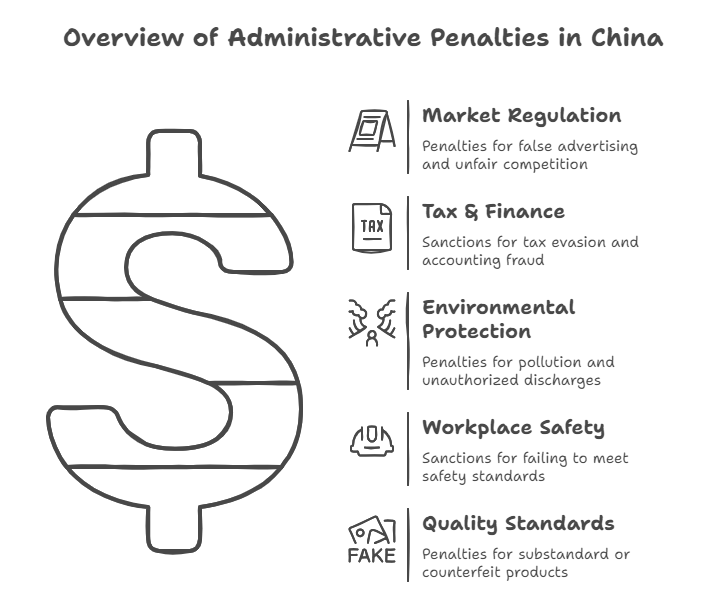Introduction: The Hidden Risk in Chinese Business Partnerships
When evaluating potential Chinese partners, international businesses often focus on financial metrics and operational capabilities. Yet one critical factor remains overlooked: administrative penalties (行政处罚). These government-imposed sanctions for regulatory violations create invisible cracks in a company’s creditworthiness that can undermine your entire business relationship. Understanding how these penalties function within China’s unique regulatory ecosystem is not just advisable – it’s essential for risk mitigation.

What Exactly Are Administrative Penalties in China?
Administrative penalties are non-criminal sanctions imposed by Chinese regulatory agencies for violations spanning:
- Market Regulation: False advertising, unfair competition, intellectual property infringement
- Tax & Finance: Tax evasion, illegal invoicing, accounting fraud
- Environmental Protection: Pollution violations, unauthorized discharges
- Workplace Safety: Failure to meet safety standards, industrial accidents
- Quality Standards: Manufacturing/selling substandard or counterfeit products
Unlike minor violations, these penalties are legally mandated public records. Crucially, they are published on the National Enterprise Credit Information Publicity System (NECIPS) – China’s official central repository for corporate compliance data. As stated in China’s Regulations on the Disclosure of Enterprise Information (2024 Revision):
“Market regulatory departments shall publicize… administrative penalty information through the National Enterprise Credit Information Publicity System” (Article 6).
Key Takeaway: Penalties are not internal warnings. They are formal, public, and legally documented sanctions.
How Penalties Directly Damage Business Credit
1. Public Shaming & Reputational Fallout:
Penalties are permanently displayed on the company’s NECIPS profile – the first stop for due diligence. Banks, suppliers, and partners actively screen this record. A 2023 EU Chamber of Commerce survey noted that 68% of European companies cited penalty visibility as a “significant factor” in Chinese partner selection.
2. Financing Barriers:
- Loan Restrictions: Banks downgrade credit scores for penalized companies. PBOC data shows penalized SMEs face 30-50% higher loan rejection rates.
- Bond Issuance Blocks: Companies with major penalties within 3 years are often barred from issuing corporate bonds (Securities Law, Art. 16).
- Equity Financing Hurdles: Penalties trigger intense scrutiny during IPO reviews. CSRC guidelines explicitly require full disclosure of all administrative sanctions.
3. Operational Handcuffs:
- Government Contract Bans: Penalties can disqualify companies from public procurement bids for 1-3 years (Government Procurement Law, Art. 22).
- Industry Access Restrictions: Severe or repeat violations may lead to suspended business licenses or market access revocation.
- Supply Chain Distrust: Major suppliers often terminate contracts with penalized partners to avoid reputational contagion.
4. The “Ripple Effect” on Credit Reports:
Penalties feed directly into third-party business credit reports, which amplify their visibility:
- Official Enterprise Credit Report: Lists all penalties from NECIPS verbatim – the gold standard record.
- Enhanced Reports: Include risk scores heavily weighted toward penalty history. Companies with environmental/safety penalties see risk scores increase by 40-60% on average.
Case Study: A Zhejiang textile exporter received a ¥2M environmental penalty in 2022. Within months: 3 key European clients terminated contracts, its credit line was cut by 60%, and a planned HK IPO was shelved. Recovery took 3 years.
Why Penalties Are Hard to Spot (and Why It Matters)
The Opaqueness Trap:
- No Automatic Alerts: Penalties are published but not proactively notified to partners.
- Fragmented Sources: Records may appear on NECIPS, ministry sites (e.g., MEE), and local portals – not centralized.
- Language & Access Barriers: Navigating Chinese platforms requires fluency and local ID verification.
The “Hidden Penalty” Risk:
Companies often omit penalties from self-disclosed reports. Verifying through NECIPS is the only way to confirm compliance status. As one compliance officer at a Fortune 500 firm noted:
“We’ve caught 7 suppliers in 2 years hiding six-figure penalties. If we hadn’t pulled the official credit report, we’d be liable for their violations.”
Protecting Your Business: Practical Steps
- Mandate Official Credit Reports:
Insist on a current Official Enterprise Credit Report (direct from NECIPS) for every partner evaluation. This isn’t optional – it’s due diligence 101.
Verify Chinese partners with our Official Enterprise Credit Report → - Decode the Penalty:
- Severity: Fines over ¥200K or “serious violation” labels indicate systemic risk.
- Recency: Penalties within 1-2 years signal active compliance issues.
- Pattern: Multiple penalties across categories (e.g., tax + environment) reveal governance failures.
- Demand Remediation Proof:
Require documented proof of corrective actions (e.g., paid fines, audit reports). Supplement with onsite audits for high-risk partners. - Continuous Monitoring:
Rescreen partners annually or after major regulatory changes (e.g., new ESG rules). Penalties can emerge anytime.
Conclusion: Penalties = Permanent Scars
Administrative penalties in China are more than fines – they’re public, persistent indicators of operational and governance risk. In a market where regulatory enforcement is intensifying (especially in environment, data security, and finance), overlooking penalties is tantamount to blindfolded risk-taking.
The solution is unambiguous: Ground every partnership decision in verified, official data. Trust, but verify – through the only source that carries the government’s seal.
